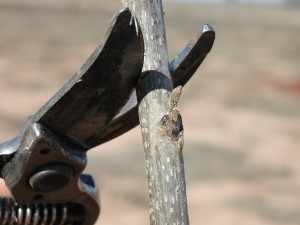Here is a good article from our UGA Pecan Extension Specialist Lenny Wells,
For many things related to pecan production, there are almost as many opinions out there about how to do something as there are people to ask. When you get varying opinions on a subject, the thing to do is look at the science behind it. Is there data to back up the practice in question or is this just the way Grandpa always did it? One practice that you can find a lot of varied opinion on is the pruning of pecan trees at planting.
When growers, particularly those new to growing pecans, purchase trees and put them in the ground, the thought of cutting off a portion of these trees they just shelled out $15-$20 for causes them to shudder. This reaction is easily understood. I have read a lot of scientific papers on pecans, including many on tree planting techniques, and I have planted thousands of nursery trees, some pruned and some not pruned. Based on both scientific results and practical experience, I can tell you without question, that if you do not prune the tree at planting you are doing that tree and yourself a grave disservice.
As trees are dug from the nursery, they lose a portion of their root system and undergo what we term “transplant shock” as they are removed from one soil environment, hauled around, and placed in another. Pruning the top of the tree by 1/4 to 1/3 alleviates the stress this generates for the tree and allows the root system to more easily support the growth that tree puts on as it grows. There is nothing magical about 1/3 or 1/4. It just depends on the tree. You may even need to remove as much as 1/2 of a 10-12′ tree at planting. The tree then puts its energy into developing strong, new shoots as opposed to just trying to keep itself alive. The result is a much more vigorous tree. By contrast, trees that are not pruned at planting usually take longer to begin growing and develop multiple weak, short shoots as it struggles to survive.
We used to recommend (and many growers still follow) the practice of pruning no more of the root system than you have to in order to get the tree in the hole. But, based on research by Dr. Mike Smith at Oklahoma State, we’ve changed that recommendation and for several years now, have promoted the pruning of roots at planting. “Pruning of roots?”, you say. “Didn’t you just say the tree loses some roots at planting”? Yes, I did. But, that’s not necessarily a bad thing.
When you prune a tree, whether the cut is on the stem or on the root, you stimulate growth. Pecan trees will grow without pruning the roots at planting but Dr. Smith’s work showed that when you prune the taproot to 18″-24″ and remove the lateral roots (at least by 1/2 the length), the tree is more vigorous and grows much better. The reason for this is that the tree’s new roots develop from the cut surface and tree survival & growth depends on new root development, not the existing root system. This also allows you to dig a smaller hole (no more than 24″ deep). When you prune the roots, pruning the top of the tree becomes even more important because you are removing more of the root system. The goal is to stimulate growth and relieve stress. Planting by proven methods such as these will do a lot more for getting pecan trees off to a good start than any fertilizer or “miracle” snake oil product you can use.
Before Pruning
After Pruning



